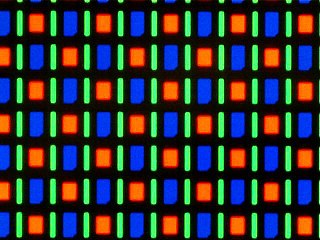Related Research Articles

A liquid-crystal display (LCD) is a flat-panel display or other electronically modulated optical device that uses the light-modulating properties of liquid crystals. Liquid crystals do not emit light directly, instead using a backlight or reflector to produce images in color or monochrome. LCDs are available to display arbitrary images or fixed images with low information content, which can be displayed or hidden, such as preset words, digits, and seven-segment displays, as in a digital clock. They use the same basic technology, except that arbitrary images are made up of a large number of small pixels, while other displays have larger elements. LCDs can either be normally on (positive) or off (negative), depending on the polarizer arrangement. For example, a character positive LCD with a backlight will have black lettering on a background that is the color of the backlight, and a character negative LCD will have a black background with the letters being of the same color as the backlight. Optical filters are added to white on blue LCDs to give them their characteristic appearance.
A metal matrix composite (MMC) is composite material with at least two constituent parts, one being a metal necessarily, the other material may be a different metal or another material, such as a ceramic or organic compound. When at least three materials are present, it is called a hybrid composite. An MMC is complementary to a cermet.
An active-matrix liquid-crystal display (AMLCD) is a type of flat panel display, the only viable technology for high-resolution TVs, computer monitors, notebook computers, tablet computers and smartphones with an LCD screen, due to low weight, very good image quality, wide color gamut and response time.

The hypothalamic–pituitary–adrenal axis is a complex set of direct influences and feedback interactions among three components: the hypothalamus, the pituitary gland, and the adrenal glands.

A thin-film transistor (TFT) is a special kind of field-effect transistor made by depositing thin films of an active semiconductor layer as well as the dielectric layer and metallic contacts over a supporting substrate. A common substrate is glass, because the primary application of TFTs is in liquid-crystal displays (LCDs). This differs from the conventional transistor, where the semiconductor material typically is the substrate, such as a silicon wafer.

A display device is an output device for presentation of information in visual or tactile form. When the input information that is supplied has an electrical signal, the display is called an electronic display.
Passive matrix addressing is an addressing scheme used in early LCDs. This is a matrix addressing scheme meaning that only m + n control signals are required to address an m × n display. A pixel in a passive matrix must maintain its state without active driving circuitry until it can be refreshed again.

Semacode is a software company based in Waterloo, Ontario, Canada. It is also this company's trade name for their machine-readable ISO/IEC 16022 Data Matrix barcodes, which are used to encode Internet URLs.

Liquid-crystal-display televisions are television sets that use liquid-crystal displays to produce images. They are, by far, the most widely produced and sold television display type. LCD TVs are thin and light, but have some disadvantages compared to other display types such as high power consumption, poorer contrast ratio, and inferior color gamut.
HPA may refer to:
A thin-film-transistor liquid-crystal display is a variant of a liquid-crystal display (LCD) that uses thin-film-transistor (TFT) technology to improve image qualities such as addressability and contrast. A TFT LCD is an active matrix LCD, in contrast to passive matrix LCDs or simple, direct-driven LCDs with a few segments.

A super-twisted nematic display (STN) is a type of monochrome passive-matrix liquid crystal display (LCD). This type of LCD was invented at the Brown Boveri Research Center, Baden, Switzerland, in 1983. For years a better scheme for multiplexing was sought. Standard twisted nematic (TN) LCDs with a 90 degrees twisted structure of the molecules have a contrast vs. voltage characteristic unsuitable for passive-matrix addressing as there is no distinct threshold voltage. STN displays, with the molecules twisted from 180 to 270 degrees, have superior characteristics. The main advantage of STN LCDs is their more pronounced electro-optical threshold allowing for passive-matrix addressing with many more lines and columns. For the first time, a prototype STN matrix display with 540x270 pixels was made by Brown Boveri in 1984, which was considered a breakthrough for the industry.

The World Health Organization (WHO) has researched electromagnetic fields (EMFs) and their alleged effects on health, concluding that such exposures within recommended limits do not produce any known adverse health effect.
Thick-film dielectric electroluminescent (TDEL) technology is a phosphor-based flat panel display technology developed by Canadian company iFire Technology Corp. TDEL is based on inorganic electroluminescent (IEL) technology and has a novel structure that combines both thick- and thin-film processes. An IEL device generates light by applying an alternating electrical field to inorganic light-emitting phosphors. Traditional IEL displays are bright, very fast in video response time and highly tolerant of environmental extremes. However, the lack of full-color capability and large-size scalability has limited their application for the mainstream consumer television market. iFire has addressed these limitations by replacing the thin-film dielectric of traditional IEL technology with its patented thick-film, high-K dielectric material and structure. The result is a unique flat panel display technology that provides iFire displays with high performance and low cost potential. iFire was unable to develop displays competitive with LCD, plasma and OLED devices and wound up research and development in 2007.

A parallax barrier is a device placed in front of an image source, such as a liquid crystal display, to allow it to show a stereoscopic or multiscopic image without the need for the viewer to wear 3D glasses. Placed in front of the normal LCD, it consists of an opaque layer with a series of precisely spaced slits, allowing each eye to see a different set of pixels, so creating a sense of depth through parallax in an effect similar to what lenticular printing produces for printed products and lenticular lenses for other displays. A disadvantage of the method in its simplest form is that the viewer must be positioned in a well-defined spot to experience the 3D effect. However, recent versions of this technology have addressed this issue by using face-tracking to adjust the relative positions of the pixels and barrier slits according to the location of the user's eyes, allowing the user to experience the 3D from a wide range of positions. Another disadvantage is that the horizontal pixel count viewable by each eye is halved, reducing the overall horizontal resolution of the image.

A video wall is a special multi-monitor setup that consists of multiple computer monitors, video projectors, or television sets tiled together contiguously or overlapped in order to form one large screen. Typical display technologies include LCD panels, Direct View LED arrays, blended projection screens, Laser Phosphor Displays, and rear projection cubes.

AMOLED is a display device technology used in smartwatches, mobile devices, laptops, and televisions. OLED describes a specific type of thin-film-display technology in which organic compounds form the electroluminescent material, and active matrix refers to the technology behind the addressing of pixels.
IPS is a screen technology for liquid-crystal displays (LCDs). It was designed to solve the main limitations of the twisted nematic field effect (TN) matrix LCDs which were prevalent in the late 1980s. These limitations included strong viewing angle dependence and low-quality color reproduction. In-plane switching involves arranging and switching the orientation of the molecules of the liquid crystal (LC) layer between the glass substrates. This is done, essentially, parallel to these glass plates.
The Hollywood Post Alliance (HPA), is a Southern California based trade association founded in 2002 by seasoned professionals and studio executives from major post facilities and manufacturers with a mission to serve the post production community. HPA produces educational conferences and seminars, provides networking opportunities for its members, acts as a "larger voice" for the industry on common issues and topics, and provides a platform for other industry-related functions.

T. P. "Peter" Brody was a British-naturalised physicist and the co-inventor of Active Matrix Thin-Film Transistor display technology together with Fang-Chen Luo, having produced the world's first Active Matrix Liquid Crystal Display (AM-LCD) in 1972 and the first functional AM-EL in 1973 while employed by Westinghouse Electric Corporation in Pittsburgh. Brody coined the term "active matrix" and first used it in a published journal article in 1975.
References
- 1 2 "Input/Output Systems and Peripheral Devices" (PDF). utcluj.ro. 2010-11-18. Archived from the original (PDF) on 2011-07-22. Retrieved 2011-01-30.
- ↑ "High-Performance Addressing - HPA". Computerhope.com. Retrieved 2011-01-30.
| This computer graphics–related article is a stub. You can help Wikipedia by expanding it. |